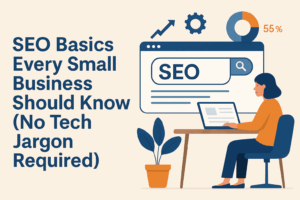
Creating a compelling blog post is no longer just about writing engaging content; it’s also about making sure your post can be found. This is where Search Engine Optimization (SEO) comes in. To increase your blog’s visibility and improve search engine rankings, a strong understanding of SEO is essential. Here is a guide to assist copywriters in creating SEO-friendly blog posts.
1. Understanding SEO and Its Importance
SEO involves using certain techniques and strategies to improve your website’s visibility in search engine results. By effectively implementing SEO, your blog post could rank higher, attract more traffic, and ultimately result in higher conversions.
2. Keyword Research
The backbone of SEO is effective keyword research. Keywords are the words or phrases people type into search engines when they’re looking for something. Identifying the right keywords is critical for your blog post to be seen by the right audience.
You can use keyword research tools like Google Keyword Planner, SEMrush, or Ahrefs to identify popular search terms related to your topic. Remember to focus not only on high-traffic keywords but also on long-tail keywords and questions your audience might ask.
3. On-Page SEO
On-page SEO includes all the measures taken within your website to improve its position in search rankings. This includes:
- Title Tags: Make sure your keyword appears in your title tag. This is one of the most significant on-page SEO factors. The closer the keyword is to the beginning of the title tag, the more weight it has with search engines.
- Meta Descriptions: While not a direct ranking factor, meta descriptions can influence click-through rates. Make your meta description enticing and include your focus keyword.
- Headers: Use headings (H1, H2, H3, etc.) to structure your content. This makes it easier for readers and search engines to understand what your post is about. Include your focus keyword in at least one subheading.
- Keyword Usage: Include your keyword in the first 100-150 words of your blog post. But remember, don’t overdo it; keyword stuffing can lead to penalties from search engines.
- URL Structure: A clean URL structure with your keyword can improve your blog’s visibility. A URL like yourwebsite.com/blog/seo-copywriting-tips is much more helpful to both users and search engines than a URL like yourwebsite.com/blog/post?id=1234.
4. Creating High-Quality Content
The mantra “Content is King” still holds true in SEO. Regardless of your SEO efforts, if your content is not valuable to your readers, your chances of ranking are low. Aim to create high-quality, engaging, and informative content that provides value to your audience. Your content should answer questions, provide solutions, or fulfill a need.
5. Optimizing Images
If your blog post includes images, don’t forget to optimize them for SEO. Use relevant file names and fill in the alt text with descriptions of the images, including your focus keyword where appropriate.
6. Internal and External Linking
Links are a fundamental part of SEO. By linking to reliable external sources, you increase your blog’s credibility. On the other hand, internal linking can help search engines understand the structure and content of your website, and can lead to improved site navigation and increased time-on-site.
7. Mobile Optimization
With the growing number of mobile users, it’s important that your blog is mobile-friendly. Google uses mobile-first indexing, which means it predominantly uses the mobile version of a website for indexing and ranking. Hence, if your blog isn’t optimized for mobile, it may affect your search engine rankings.
8. User Engagement
Engagement metrics like time on page, bounce rate, and click-through rate are all signals that can influence rankings. Engage your readers by writing interesting, easy-to-read content. Encourage comments, shares, and other interactions.
Conclusion
By keeping these key SEO aspects in mind, copywriters can not only create compelling, engaging content but also ensure it’s found by the right audience. SEO-friendly blog writing is a skill that takes time to master, but with continuous learning and practice, it can lead to impressive results in search engine rankings and traffic.
Do you have questions on how to best reach your target audience? Do you have a marketing budget but aren’t sure how to allocate those funds for an optimal ROI? Are you in need of an updated website? If you have any questions or need assistance with your marketing efforts, we want to hear from you! Schedule your FREE Consultation to find out how we may be able to help take your business to the next level.
“The secret to getting ahead is getting started.” – Mark Twain




